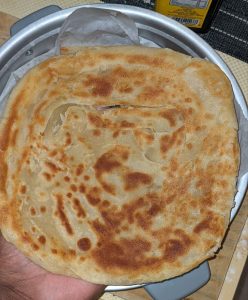Matoke is a green banana dish that is popular in most East African countries however, it is mostly approved in Uganda which makes it the national dish.
In Rwanda, the common name is ibitoke or igitoke. In Tanzania simply ndizi which translates to banana from Swahili. In Uganda matooke while in Kenya matoke. Enough with the Linguistics class 🙂
Matoke dish uses a special type of green banana known as the East Africa Highland Banana which is characterized by high starch content, and low sugar levels, and is normally short and plump in length.Matoke is not plantain.
Green plantain isn’t recommended for this tho it can work as well.
Lastly matoke is a versatile dish with endless ways to make it ; matoke is cooked differently in different regions.In Kenya it is mostly stewed and cooked with beef.
In Tanzania it is curried, with the addition of coconut milk while in Uganda, it is boiled then steamed, and finally mashed.
1. Traditional Style Steamed Matoke
Peel bananas by chopping off both ends and slit them shallow lengthwise, rinse in cold water, cut bananas into chunks, salt cooking water in a pot, add bananas, and cook on medium-high heat till they start boiling then proceed to lower heat and cook till fork tender
Drain the excess water and mash the bananas till smooth with zero lumps. Wash banana leaves and cut them into large squares then proceed to add your mashed bananas to the center then fold and wrap it on itself. Use another banana leaf to wrap again folding the edges
Now for steaming…use chopped banana stalks to raise the wrapped banana mash then add water. If you have technology use a rice cooker steamer. Add water and cover. Steam for like 30 minutes to 1 hour
![Matoke steamed in banana leaves [Pintrest @elacethomestay] Matoke steamed in banana leaves [Pintrest @elacethomestay]](https://img1.wsimg.com/isteam/ip/d0e5736f-1d23-476a-a37a-f536dea1b248/1b8f30f18e887706cf5de5925577cbb9.jpg/:/cr=t:0%25,l:0%25,w:100%25,h:100%25/rs=w:1280)
Remove the steamed banana and serve with proteins of your choice. Traditionally the steamed matoke is served on a woven basket that is lined with banana leaves. The leaves used are the young fresh ones and the midrib is sliced off

2. Mashed Matoke
Since mashed potatoes are a thing, why can’t mashed matoke be something? Potato crisps have an alternate matoke crisps so should mashed potatoes. Well, I tried it and I’m glad I didn’t make poison since I’m here whacking on the keyboard.
Cut the edges of your banana and slice through along the skin, not so deep just scour the thick green skin. Salt your water just as I imagine the universe did to the ocean, and cook on high heat for 10 minutes.
Drain the boiling water and run your bananas through cold water to stop them cooking and cool them down as well. Minutes later peel off the skin and cut the bananas across into small pieces. Using a masher mash them down adding warm milk or beef broth till the smoothness you want them.
Finish off with pepper and adjust salt if required, add your favorite garnishes and diced onions for extra texture and there you have it!
You can opt to add creamy peanut sauce on top of your mashed matoke. To make peanut(groundnut) sauce simply combine peanut butter with tomatoes and onions, optionally ginger and garlic, and cook with 2tbs of oil till it boils and thickens. You can add spices of your choice.
3. Matoke with mashed potatoes and pumpkin or butternut squash
Just like like the classic mashed matoke above, this one is the same thing but on steroids. It is more flavorful and creamier thanks to the pumpkin, or butternut squash depending on what you choose.
Peel like 5 bananas and cut them, 2 medium potatoes and cube them then finally some pumpkin or butternut squash like 3 large chunks will do fine. Keep in mind the butternut cooks quicker compared to the other ingredients so maybe add it on a later cooking stage or just cut it into bigger pieces.
Cook onions, tomatoes, garlic, and ginger in oil till reduced. Add your cubed bananas, potatoes, and butternut and saute them. Add any desired spices then add water or broth to cook till tender. Proceed to mash and serve with spring onion leaves garnish
4. Matoke with Beef
You are not limited to beef, lamb works as a great substitute and the procedure is the same. This is a one-pot dish as both the bananas and beef are cooked together in the same pot, thus one pot.
Cube your beef into small pieces, peel bananas, and cut them into pieces, dice onions tomatoes ginger, and garlic.
Start with oil in a pot, and cook onions till translucent add garlic and ginger paste followed by tomatoes cook till withered. Add dry spices of your choice followed by beef cook for like 10 minutes before proceeding to add the banana pieces, cook the mixture for 5 more minutes then add water to cover the mixture, you can use broth instead of water for an even richer flavor.
Alternatively, add a beef spice cube and cover. Reduce heat to low and simmer the dish covered for over 30 minutes. Add more water or broth if it runs dry before cooking. Once done to your liking garnish with your favorite herbs and serve.
![Beef Matoke [Instagram @infoods_special]](https://toasterding.com/wp-content/uploads/2024/06/image-3.jpeg)
5. Matoke Coconut Curry
Just like in the beef matoke general recipe, everything holds the same except instead of using water or broth as our liquid we use coconut milk and curry powder. Coconut cream can be used but it should be mixed with water to form coconut milk. You can also use the powdered coconut cream by dissolving it into water as per package instructions.
However, you will get better results by using canned coconut milk as opposed to powdered cream. Use the same amount of coconut milk as water you would use. Cook till the white color turns to yellow and bright orange and your matoke is fork tender. Garnish with desiccated coconut and your favorite herbs
Peeling Matoke
Now this is an extreme sport, I don’t know why it isn’t sponsored by Redbull yet. Matoke is notorious for gluing your hands up whenever you peel it, the glue is very sticky and doesn’t come off entirely even after using ridiculous amounts of soap and hot water. However, there are two ways around this
- Oil your hands before attempting to peel your matoke. Oil forms a layer between your hands and the peeling glue, also it makes your hands so slippery that the glue won’t stick. Reminds me of cohesion and adhesion forces in science.
In this case, the adhesion is hindered so your hands won’t be sticky, but the trade-off is, they will be oily tho lol. I mean oily hands ain’t that bad unless you touching stuff and they keep slipping through. Also, oily hands get cleaned in seconds by the use of soap. Ooh, and by oil I mean vegetable or any cooking oil, not WD-40
2. Boil your matoke first. Not per see boil but more of parboil. First slit through the skin with a knife along the length, don’t slit through the banana, just the skin. Chop off the ends and slit the opposite side of the initial cut as well. Salt your water and boil for just under 10 minutes. Your matoke will be easy peasy (literally) to peel. Then proceed as you wish.
Important: After peeling your matoke make sure you immerse them in water to prevent them from blackening or oxidizing just like avocados. The water should be acidic for good results. Add citric acid, or vinegar to achieve this. A lemon contains citric acid as well.
Recommended Links
17 Popular Food Dishes in Kenya; Mega Compilation
3 Ingredients Flaky Layered Chapati: East Africa’s Flatbread.
Swahili Pilau Recipe: Pilau ya Nyama



